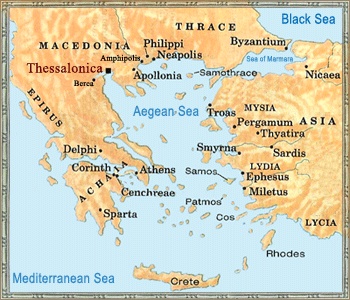Greetings,
 Thessalonica was a commercially important city in Greece. It was named after the step-sister of Alexander the Great. It was a free city ruled by a council of its own citizens—a perk they received by being on the winning side during the Roman civil wars.
Thessalonica was a commercially important city in Greece. It was named after the step-sister of Alexander the Great. It was a free city ruled by a council of its own citizens—a perk they received by being on the winning side during the Roman civil wars.
Many religions were represented there in addition to Judaism. Among them were Heracles, Apollo, Aphrodite and Egyptian gods and cults.
Paul first visited Thessalonica on his second missionary journey in about 49AD. The account of that visit is given in Acts 17.
Paul’s letter to the Thessalonians reflects his respect and love for the Thessalonians. In his letter he further instructs a spiritually healthy church how they can continue to improve and draw closer to God. In his introductory remarks he describes them this way:
2 We give thanks to God always for all of you, constantly mentioning you in our prayers, 3 remembering before our God and Father your work of faith and labor of love and steadfastness of hope in our Lord Jesus Christ.
4 For we know, brothers loved by God, that he has chosen you, 5 because our gospel came to you not only in word, but also in power and in the Holy Spirit and with full conviction. You know what kind of men we proved to be among you for your sake. 6 And you became imitators of us and of the Lord, for you received the word in much affliction, with the joy of the Holy Spirit, 7 so that you became an example to all the believers in Macedonia and in Achaia. 8 For not only has the word of the Lord sounded forth from you in Macedonia and Achaia, but your faith in God has gone forth everywhere, so that we need not say anything. 9 For they themselves report concerning us the kind of reception we had among you, and how you turned to God from idols to serve the living and true God, 10 and to wait for his Son from heaven, whom he raised from the dead, Jesus who delivers us from the wrath to come.
Paul describes them as a model church. He says their faith is known to God’s people everywhere. They have endured hard times and turned from the false religions around them to serve the one true God. In short, they represented Christ well.
In verse 3 Paul highlights three characteristics that drives their reputation and spiritual health: faithfulness, love for one another, and steadfastness of hope. These three are critical to a healthy church for Paul mentions them again to the Corinthians in 1 Corinthians 13:13:
13 And now these three remain: faith, hope and love. But the greatest of these is love.
These are three characteristics that we need to focus on so that it may one day be said of us that our “faith in God has gone forth everywhere, so that we need not say anything.”
Michael McKinney